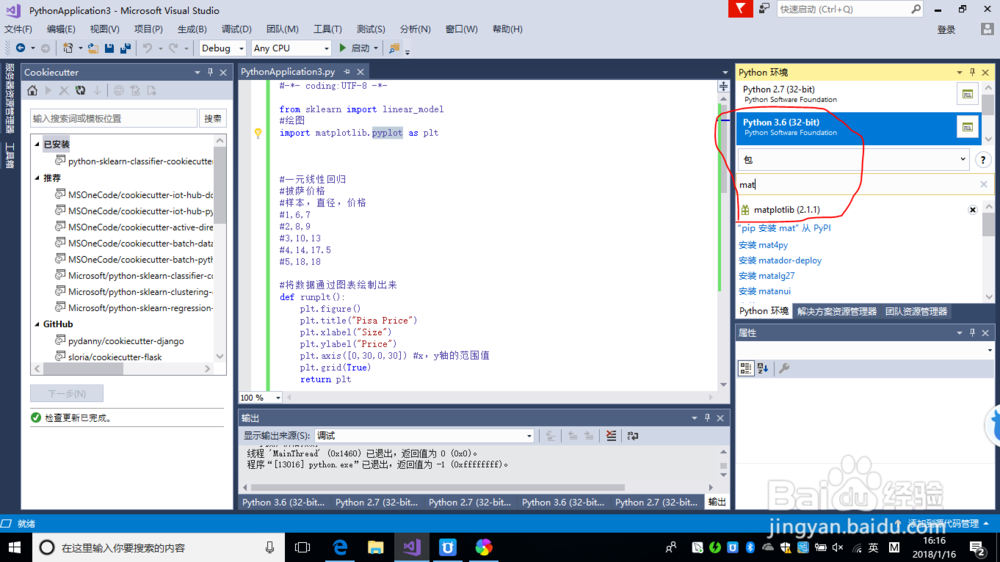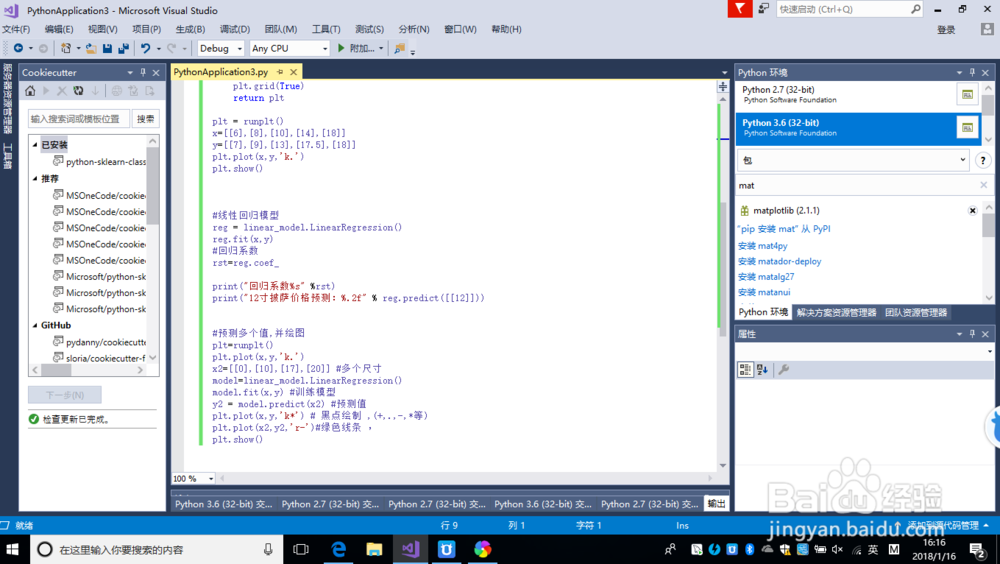1、使用Visual Studio 2017创建一个Python工程,Python采用3.6版本,Python需要安装matplotlib和sklearn库


2、在Python 文件中需要引入sklearn的线性模型和matplotlib绘图包from sklearn import linear_model#绘图import matplotlib.pyplot as plt
3、我们选择一元线性回归的算法,这里我们使用如下样例数据“披萨价格和披萨尺寸的关系”数据如下:#样本,直径,价格#1,6荑樊综鲶,7#2,8,9#3,10,13#4,14,17.5#5,18,18将数据绘制成图表#将数据通过图表绘制出来def runplt(): plt.figure() plt.title("Pisa Price") plt.xlabel("Size") plt.ylabel("Price") plt.axis([0,30,0,30]) #x,y轴的范围值 plt.grid(True) return pltplt = runplt()x=[[6],[8],[10],[14],[18]]y=[[7],[9],[13],[17.5],[18]]plt.plot(x,y,'k.')plt.show()

4、使用一元线性回归模型进行训练我们的数据,并预测单个值如我们采用步骤3的数据训练模型后,预测12寸的披萨价格:#线性回归模型reg = linear_model.LinearRegression()reg.fit(x,y)#回归系数rst=reg.coef_print("回归系数%s" %rst)print("12寸披萨价格预测:%.2f" % reg.predict([[12]]))

5、使用一元线性回归模型预测多个值,并在通过图的方式绘制出来#预测多个值,并绘图plt=runplt()plt.plot(x,y,'k.')x2=[[0],[10],[17],[20]] #多个尺寸model=linear_model.LinearRegression()model.fit(x,y) #训练模型y2 = model.predict(x2) #预测值plt.plot(x,y,'k*') # 黑点绘制 ,(+,.,-,*等)plt.plot(x2,y2,'r-')#绿色线条 ,plt.show()

6、完成的python代码如下:#-*- coding:UTF-8 -*-from sklearn import linear_model#绘图import matplotlib.pyplot as plt#一元线性回归#披萨价格#样本,直径,价格#1,6,7#2,8,9#3,10,13#4,14,17.5#5,18,18#将数据通过图表绘制出来def runplt(): plt.figure() plt.title("Pisa Price") plt.xlabel("Size") plt.ylabel("Price") plt.axis([0,30,0,30]) #x,y轴的范围值 plt.grid(True) return pltplt = runplt()x=[[6],[8],[10],[14],[18]]y=[[7],[9],[13],[17.5],[18]]plt.plot(x,y,'k.')plt.show()#线性回归模型reg = linear_model.LinearRegression()reg.fit(x,y)#回归系数rst=reg.coef_print("回归系数%s" %rst)print("12寸披萨价格预测:%.2f" % reg.predict([[12]]))#预测多个值,并绘图plt=runplt()plt.plot(x,y,'k.')x2=[[0],[10],[17],[20]] #多个尺寸model=linear_model.LinearRegression()model.fit(x,y) #训练模型y2 = model.predict(x2) #预测值plt.plot(x,y,'k*') # 黑点绘制 ,(+,.,-,*等)plt.plot(x2,y2,'r-')#绿色线条 ,plt.show()
